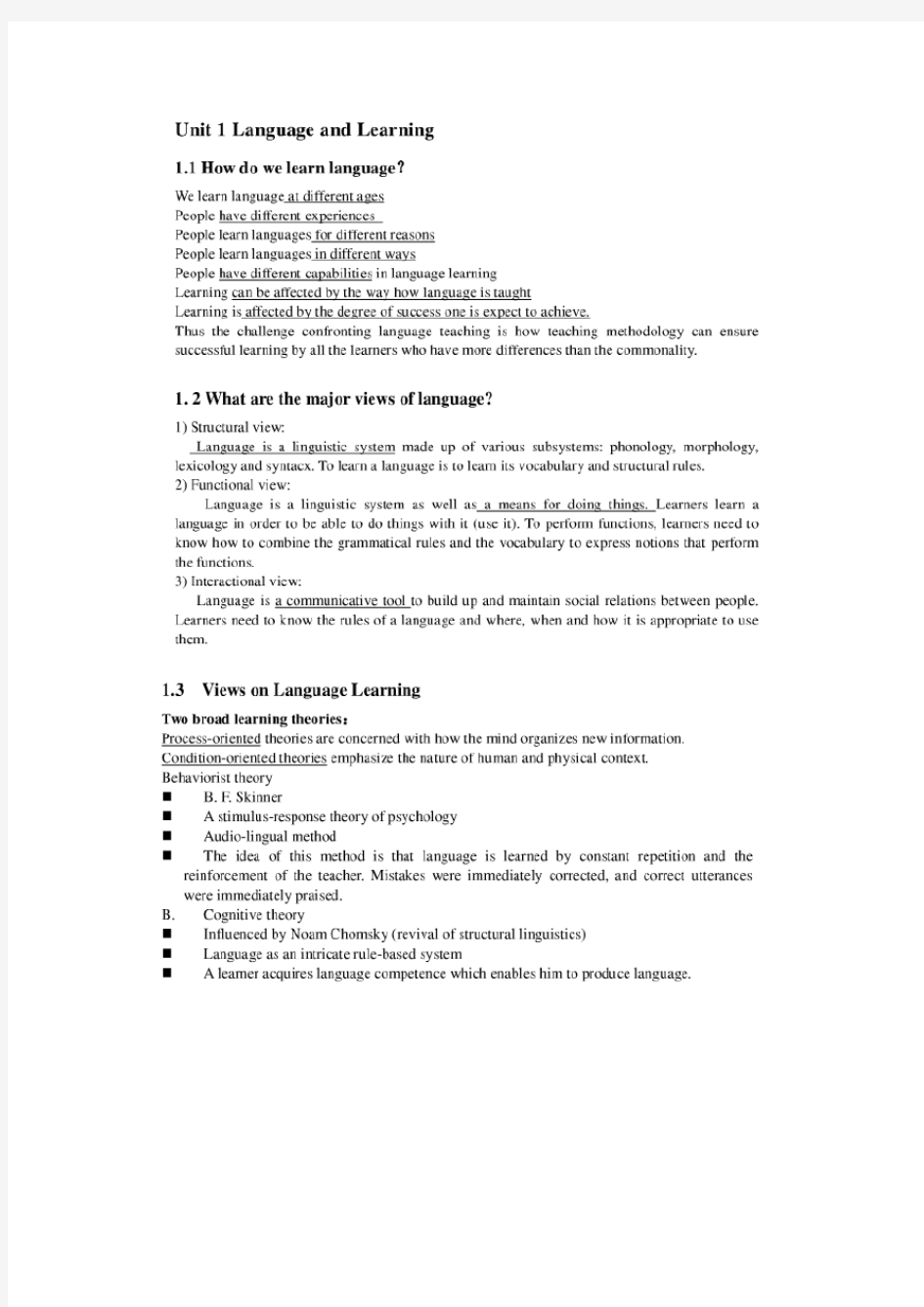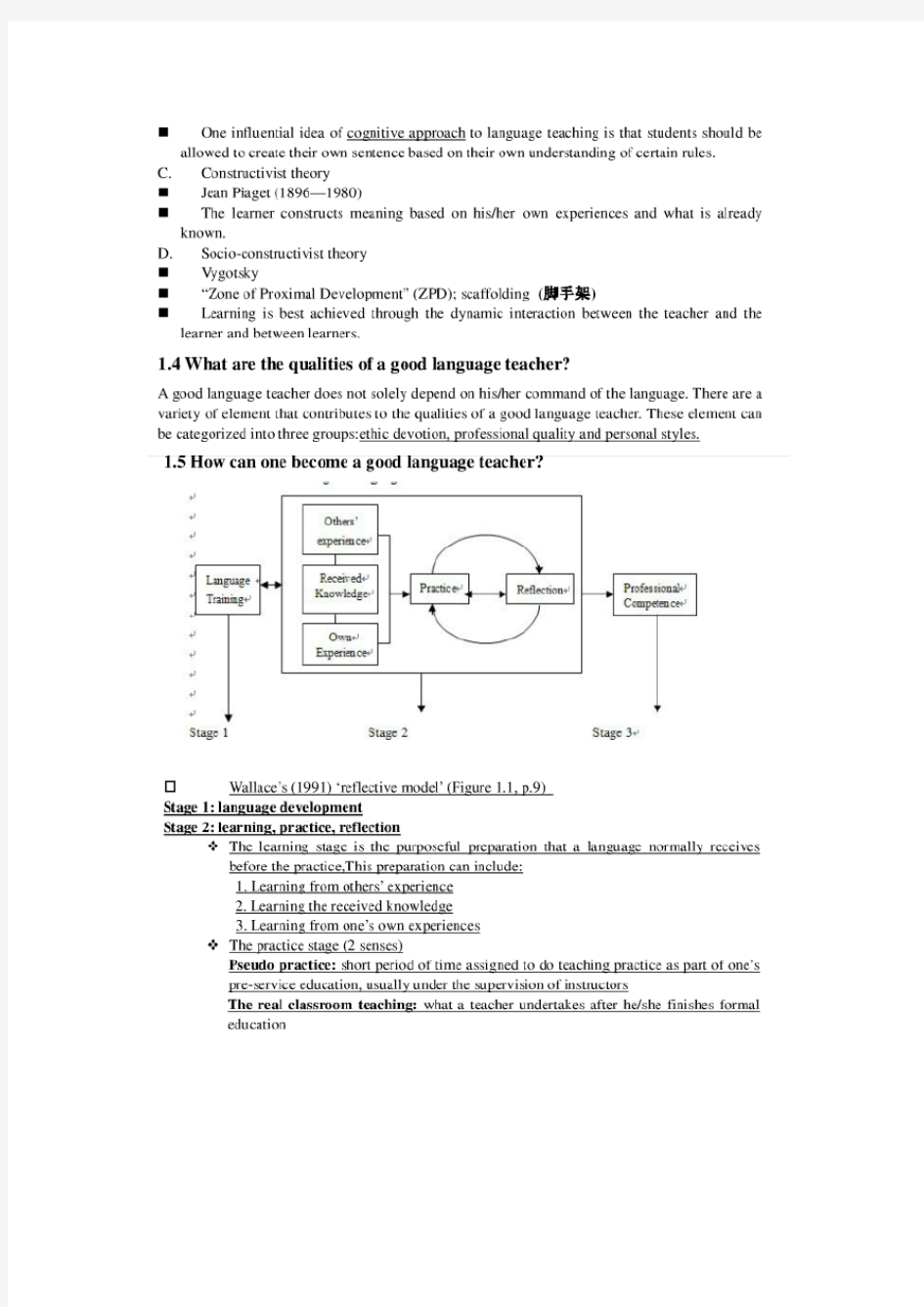

英语教学法教程教案 A Course in English Language Teaching 主讲:姚向礼 教材:《英语教学法教程》 主编:王蔷 出版社:高等教育出版社 绪论外语教学法主要流派 Teaching approaches & Methods Approaches & methods of Language Teaching 众说纷纭,现以学习理论作为分类标准,将学派分为认知性的,连接性的和综合性的三大类。并简介翻译教学法,自然教学法,直接教学法,认知教学法,功能教学法,在这之前首先概述一下拉丁语教学法、。 ①拉丁语教学法,指(15-16世纪)为欧洲语言的极盛时期,学校里教授作为外语之拉丁语的直觉模仿法。它在(15——16世纪)为语法模仿法:16世纪末到17世
纪,由于民族语渗入学校,拉丁语教学法主要为词汇模仿法。先后提出了自觉性原则和直观性原则。这一时期的两大代表人物①惜提哈(ratch1571-163500))②夸美纽斯教学法Conienius(1592_1670) ①德国论点是通过经验与分析去学习一切。认为只从理论途径得到的记忆才是可 靠的。词汇翻译法,自觉对比法,认真教学法。 二、联结性的教学法学派 特点:经验主义的哲学观点;重视外语话语与实物,观念,概念等外部世界与思维的直接联系;侧重口头操练。 自然教学法(绝对排斥本族语的教学法) 直接教学法(自然教学法发展起来的)(一种习惯) 听说教学法 视听教学法 功能教学法(又名意念法,交际法或意念——功能—交际法 三、综合性的教学法学派,来源于直接法与翻译的综合 自觉实践法 折衷法(又是极端) 分阶段教学法 一、语法翻译法(Translation Method) The grammar translation Method(Reading Method ,classical Method ).In China, it is called old method and is probably the most widely known and has been the most widely used of all approaches to language teaching .Although there have been many developments in language teaching, especially in the teaching foreign language ,grammar-translation method in still used today in various forms .And the main drill in translation. The mains features are as the followings. 1.Classes are taught in the mother tongue,with little active use of the target lauguage. 2.Much vocabulary is taught in the form of lists of isofated words. 3.Long elaborate explanations of the intricacies of grammar are given. 4.Little attention explanations of the intricacies of grammar are given. 5.Often the only drills are exercises in translation disconnecfecl sentences from the target language into the mother tongue. 6.little or no attention is given to pronunciation. 希腊文、拉丁文、通过翻译来学习外语。 认为背诵文法规则是学习外语的捷径,使用的课本,开始是孤立的单词和孤立的语法例句,都是从希腊文和拉丁文的名著里摘引出来的。 Advontedges: 1.在外语教学里创建了翻译的教学形式; 2.在外语教学里利用文法、利用学生的理解力,以提高外语教学的效果; 3.着重阅读,着重学习原文或原文文学名著; 4.使用方便。只要教师掌握了外语的基本知识,就可以拿着外语课本教外语,不需要什么教具和设备。 Disadvanfudges: 1.忽视口语教学。在教学里没有抓住语言的本质; 2.忽视语音和语调的教学; 3.过分强调翻译,单纯通过翻译手段教外语,不利于培养学生用外语进行交际的能力,易使学生在使用外语时对翻译有依赖性;
WORD2000的版面设计样文实习步骤及方法: 1.6.1 版面设计纸型大小: (1)、建立一个新的文档。 (2)、菜单栏[文件],[页面设置]。 (3)、[页边距](上:2.5CM;下:1.6CM;左:2.5CM;右: 1.5CM;页眉、页脚为0CM)。 (4)、[纸型]选择(16开)。 (5)、[文档网格],[字体设置],选择(宋体、常规、小四)。(6)、最后[确定]。 1.6.2 纸型设计完毕后,记住一定要多回车。 (回车完毕后,才可以打字) 1.6.3 页眉的制作方法: (1)、选定所需要制作页眉的文字。 (2)、菜单栏[格式],[边框和底纹]。 (3)、[边框]选择(方框);[线型](根据需要进行选择);[应用范围]选择(段落);上、左、右线条不要。 (4)、最后点击[确定]。 1.6.4 文件头的制作方法: (1)、选定所需要制作文件头的文字。 (2)、在工具栏中有个[字号]选择最大(72号);[B](加粗);[字体缩放] 选择(33%);右对齐;[字体颜色] 选择(红色)。 1.6.5 图片的插入方法: (1)、所需的图片在微软画笔中制作完毕后。 (2)、选定制作好的图片,鼠标点击菜单栏[编辑],[复制]。 (3)、回到WORD文档中,在所需粘贴图片的位置,点击,粘贴 。(4)、对粘贴过来的图片,右击,[设置对象格式],[版式],[四周型]。 (5)、最后根据需要,对图片进行大小调整。
1.6.6 首字下沉制作方法: (1)、选定所需首字下沉的文字。 (2)、菜单栏[格式],[首字下沉]。 (3)、选择[下沉](其它默认,也可以根据需要进行修改。) 1.6.7 字符背景制作方法: (1)、选定所需制作背景颜色的文字或段落。 (2)、菜单栏[格式],[边框和底纹]。 (3)、[底纹],[颜色](根据需要进行选择);[应用范围]选择(段落)。 1.6.8 字符缩放制作方法: (1)、选定所需缩放的文字。 (2)、菜单栏[格式],[段落]。 (3)、[左](缩进2个字符);[右](缩进2个字符);[段前、段后](各缩进1个行)。 1.6.9 段落分栏制作方法: (1)、选定所需分栏的文字。 (2)、菜单栏[格式],[分栏]。 (3)、选择(分二栏),分隔线勾勾上。
Unit 1 一,Views on language: 1、Structural view (language competence)结构主义语言观 —The founder:Saussure,lasen freeman&long —The structural view of language sees language as a linguistic system made up of various subsystems:1、the sound system(phonology)2、sound combinations(morphology)the discrete units of meaning 3、the system of combining units of meaning for communication(syntax) —The structural view limits knowing a language to knowing its structural rules and vocabulary 2 、Functional view功能主义语言观 —Representative:Johnson、marrow、swain canal (the core: grammar) —The function view not only sees language as a linguistic system but also a means for doing things功能不仅认为语言是一个语言系统,但也做事情的一种方式 —Learners learn a language in order to be able to doing things with it Use the linguistic structure to express functions 3、Interactional view 交互语言观(communicative competence) —Emphasis:appropriateness —Language is a communicative tool,which main use is to build up and maintain social relations between people —Learners need to know the rules for using the language in certain context 二,View on language learning语言学习观 1.Process-oriented theories:强调过程are concerned with how the mind organizes new information such as habit formation, induction, making inference, hypothesis testing and generalization. 2.Condition-oriented theories: 强调条件emphasize the nature of the human and physical context in which language learning takes place, such as the number of students, the kind of input learners receives, and the atmosphere. 3.Behavioristtheory,(Skinner and waston raynor) A the key point of the theory of conditioning is that” you can train an animal to do anything if yo u follow a certain procedure which has three major stages, s timulus, response, and reinforcemen t B the idea of this method is that language is learned by constant repletion and the reinforcement of the teacher. Mistakes were immediately corrected, and correct utterances were immediately praised. 4.Cognitive theory:Chomsky)thinks that language is not a form of behavior,it is an intricate rule-based system a nd a large part of language acquisition is the learning of this system.There are a fin ite number of grammatical rules in the system and with knowledge of these an infinite number of sentences can be produced. 5.Constructivist theory:(John Dewey)the constructivist theory believes that learning is a proces in which the learner constructs meaning based on his/her own experiences and what he/he r already knows 6.Socio-constructivist theory: (Vygotsky) he emphasizes interaction and engagement with the tar get language in a social context based on the concept of “Zone of Proximal Development” (Z
1、设置页码从任意页开始算起 (1)分开目录与正文 不管你的目录有多少页,首先要做的就是将你的目录与正文分开(作用就如同将目录与正文分别存为两个文件一样,可以分别进行不同的操作),操作是将光标定位到正文第一个字之前,使用“插入”菜单中的“分隔符”命令,进入后在“分隔符”窗口下部“分节符类型”选项栏中点选“下一页”,确定后退出。这时文档就分为目录与正文两节。接下来要做的就是分别设置不同的格式了。 (2)分别设置 首先分别将光标定位在目录与正文所在页,再分别使用“文件”菜单中的“页面设置”命令,进入后在“页面设置”窗口选择“版式”选项页,在该页下部“应用于”下拉选项框中选择“本节”,确定后退出(通常插入分节符后该处系统默认为本节,为保操作无误最好用此步骤分别确认一下)。 由于目录与正文唯一的页面区别就在于有没有页码,所以只要对页码格式进行设置就可以了,不需要再对其它格式进行设置。首先删除目录的页码(如果原来就没有可以不用进行该步),接着将光标定位在正文所在页,使用 “视图”菜单中的“页眉与页脚”命令,进入后在“页眉与页脚”对话框中点击“链接到前一个”按钮(工具栏中第九个按钮)取消链接,再点选“设置页码格式”按钮(第四个按钮)进入后,在“页码格式”对话框下部“页码编排”选项栏中勾选“起始页码”,并根据你的要求在“起始页码”后的空白框中选择正文第一页的页码,本例中是1,确定后退出。 这样就完成了目录与正文页码的设置,使用分隔符可以将文档分成若干个部份分别进行设置,可以应用于很多方面,你可以试试不同的设置操作 第二种:1.从插入页码的前一页,(从最前面插入)插入——分隔符——下一页——确定; 2.视图——页眉页脚; 3.找到要插入页码的那一页的页脚——插入点放到页脚——页眉页脚工具栏——链接到前一个(取消选中); 4.插入——页码——确定。 2、word有的字或公示显示不完整 这是因为您的Word文档的行距设置得太小了,导致行的距离比文字字号的高度还小,因此,就显示不完整了,解决的办法如下。选中显示不完全的文字对象,然后如下图一样,执行菜单操作“格式”→“段落”。 弹出的对话框 行的高度就比文字的高度小,因此,文字就显示不完整了。
(开放专科)英语教学法期末复习资料 Ⅰ. Choose the best answer Directions: In this part, you are given ten questions which are followed by 4 choices marked A, B, C and D. Read the choices carefully and choose the one that can best answer the question. 1. Which of the following is characteristic of children in learning a foreign language? A. They pay more attention to meaning than to form. B. They have a clear purpose in learning a foreign language. C. They can monitor their own learning. D. They can concentrate for a long time in class. 2. Which of the following is focused on writing? A. Labeling pictures according to their contents. B. Sequencing the pictures according to the story. C. Matching the pictures with the headings. D. Commenting on the pictures. 3. Which of the following activities helps train logical thinking best*. A. Story telling. B. Finding patterns. C. Interviewing. D. Mind mapping. 4. Which of the following should we examine if we want to assess the students' intrapersonal intelligence? A. Performance in a discussion. B. Posters. C. Learning diaries. D. Performance in an interview. 5. What does the following practise? I want you to send ^ it out in ^ a minute. I have collected a ^ lot^ of monkey stamps. A. Stress. B. Intonation. C. Pronunciation. D. Liaison. 6. Which of the following can help to present A. Realia. B. Miming. C. Examples. D. Pictures. 7. What strategy does "creating a situation for students to use the words" help to train? A. Association. B. Association. C. Contextualization. D. Collocation. 8. Which of the following activities can be used at the practice stage of vocabulary instruction? A. Completion exercises. B. Reading to discover the meaning of words. C. Cross-word puzzles. D. Teacher explaining the usage of words. 9. Which of the following is a communication activity? A. Bingo. B. Information transfer. C. Substitution. D. Twenty questions. 10. Which of the following can train oral proficiency? A. Flow chart dialogue. B. Distant dictation. C. Sequencing pictures. D. Labeling pictures. 11. Which of the following activities help to train reading? A. Drawing according to oral instructions. B. Designing praising cards.
Unit 1 Language and Language Learning Aims of the unit In this unit we will discuss some general matters about language learning and teaching. We are going to discuss five questions on particular: 1.How do we learn language 2.What are the common views on language 3.What are the common views on language learning 4.What are the qualities of a good language teacher 5.How can one become a good language teacher 1.1How do we learn languages Mach of human behavior is influenced by their experiences. The way language teachers teach in the classroom is to some extent influenced by the way they learned languages. This is especially true in foreign language teaching. Before we discuss language learning theories, let us first reflect on our own language learning experience. Task 1 Below is a list of interview questions on how people learn a foreign language. In the first column, write down your own responses. Then interview three other students in your class and enter their responses in the other columns. Discuss your findings in group of 4 and draw some conclusion.
《小学英语教学法教程》期末复习知识点 Unit1 children as language learners 1、How do children acquire their first language in general?(p2) By imitations 、repetitions 、listening to stories ...... Discussion point : language learning is a socializing process,interaction and experimenting with the language in communication are important ways for language learning 2、What are the differences and similarities between learning L1 and L2?(p6 D:the length of time 、 opportunities for experimenting with language S:Rich context and input ,opportunities for using the language ,interaction with others ,etc.are important in learning any languages . 3、Children ’s characteristics/suggestions for teachers(p10) 4、Ways to nurture children ’s motivation (p11 五点会判断即可 ) 5、P12 discussion point 、p20 1.5.1 (理解、会判断即可 ) 6、How do you understand humanistic education?(p21-22 ) Humanistic education requires teachers to treat children as human beings who have their own thoughts and needs.Teachers should never try to force their ideas into children ’s minds and should always try to think the same level as children. Discussion point : Children need to learn to try new languages and
右栏:课堂的笔记(标出重点;轮廓做好) 左栏:总结(用大括号括着右边的内容);为了结合要点所提出的问题;总结的图表 下面:关键词(重要的点,用一种颜色的笔写TOP);自己的感想和经验(BOTTOM) 只记载一页,空白一页; 一章过后或几章过后,空白一页画一个各个概念间关系图表,然后以后看图表,关键词,笔记的方式来复习 一、5R笔记法 5R笔记法,又叫做康乃笔记法,是用产生这种笔记法的大学校名命名的。这一方法几乎适用于一切讲授或阅读课,特别是对于听课笔记,5R笔记法应是最佳首选。这种方法是记与学,思考与运用相结合的有效方法。具体包括以下几个步骤: 1.记录(Record)。在听讲或阅读过程中,在主栏(将笔记本的一页分为左大右小两部分,左侧为主栏,右侧为副栏)内尽量多记有意义的论据、概念等讲课内容。
2.简化(Reduce)。下课以后,尽可能及早将这些论据、概念简明扼要地概括(简化)在回忆栏,即副栏。 3.背诵(Recite)。把主栏遮住,只用回忆栏中的摘记提示,尽量完满地叙述课堂上讲过的内容。 4.思考(Reflect)。将自己的听课随感、意见、经验体会之类的内容,与讲课内容区分开,写在卡片或笔记本的某一单独部分,加上标题和索引,编制成提纲、摘要,分成类目。并随时归档。 5.复习(Review)每周花十分钟左右时间,快速复习笔记,主要是先看回忆栏,适当看主栏。 这种做笔记的方法初用时,可以以一科为例进行训练。在这一科不断熟练的基础上,然后再用于其他科目。 二、符号记录法 符号记录法就是在课本、参考书原文的旁边加上各种符号,如直线、双线、黑点、圆圈、曲线、箭头、红线、蓝线、三角、方框、着重号、惊叹号、问号等等,便于找出重点,加深印象,或提出质疑。什幺符号代表什幺意思,你可以自己掌握,但最好形成一套比较稳定的符号系统。这种方法比较适合于自学笔记和预习笔记。在操作时你应注意以下一些准则: 1.读完后再做记号。在你还没有把整个段落或有标题的部分读完并停下来思考之前,不要在课本上做记号。在阅读的时候,你要分清作者是在讲一个新的概念,还是只是用不同的词语说明同样的概念,你只有等读完这一段落或部分以后,才能回过头来看出那些重复的内容。这样做可使你不至于抓住那些一眼看上去仿佛很重要的东西。 2.要非常善于选择。你不要一下子在很多项目下划线或草草写上许多项目,这样会使记忆负担过重,并迫使你同一时刻从几个方面来思考问题,也加重你的思维负担。你要少做些记号,但也不要少得使你在复习时又只好将整页内容通读一遍。 3.用自己的话。页边空白处简短的笔记应该用你自己的话来写,这是因为自己的话代表你自己的思想,以后这些话会成为这一页所述概念的一些有力的提示。 4.简洁。在一些虽简短但是有意义的短语下划线,而不要在完整的句子下面划线, 页边空白处的笔记要简明扼要。它们会在你的记忆里留下更为深刻的印象。在你背诵和复习的时候用起来更可得心应手。
总目标是使学生在义务教育阶段英语学习的基础上,进一步明确英语学习的目的,发展自主学习和合作学习的能力;形成有效的英语学习策略;培养学生的综合语言运用能力。综合语言运用能力的形成建立在语言技能、语言知识、情感态度、学习策略和文化意识等素养整合发展的基础上。语言技能和语言知识是综合语言运用能力基础。情感态度是影响学生学习和发展的重要因素。学习策略是提高学习效率、发展自主学习能力的先决条件。文化意识则是得体运用语言的保障,这五个方面共同促进综合语言运用能力的形成。 Principles of communicative language teaching(CLT) Communication principle:activities that involve real communication promote learning Task principle:activities in which language is used for carrying out meaningful taskspromote learning Meaningfulness principle: language that is meaningful to the learner supports the learning process Listening and speaking skills need to be refined in terms of the real communicative use,Students should have the chance to listen to and produce what is meaningful, authentic, unpredictable, and creative if possible. Reading is extract meaning or information and the learning of grammar and vocabulary is to facilitate the process Writing:In CLT, students have the chance to write to express their own feelings or describe their own experiences, thus making the practice of writing meaningful and authenticLanguage content (to incorporate functions); CLT just has only expanded the areas Learning process (cognitive style and information processing); and Product (language skills). Task-based Language Teaching (TBLT) Task-based Language teaching is, in fact, a further development of Communicative Language Teaching. It shares the same beliefs, as language should be learned as close as possible to how it is used in real life. It has stressed the importance to combine for m-focused teaching with communication-focused teaching Four components of a task A purpose: making sure the students have a reason for undertaking the task. If the students don't understand why they undertake the task, they will lost interest and the task will face failure. A context: the task can be real, simulated or imaginary, and involves sociolinguistic issues, such as the location, the participants and their relationships, the time and other important factors. A process: getting the students to use learning strategies such as problem solving reasoning, inquiring, conceptualizing and communicating. A product: there will be some form of outcome, either visible (a written plan, a play, a letter. etc.) or invisible (enjoying a story, learning about another country, etc.) The PPP Model & The 5-step teaching method 3p:Step I. Presentation Step II. Practice Step III. Production 5-step Model:Step I. Revision Step II. Presentation Step II. Presentation Step IV. Practice Step V. Consolidation Differences between PPP and TBL:1.The way students use and experience language in TBL is radically different from PPP 2.TBL can provide acontent for grammar teaching and form-focused activities.PPP is different in this aspect. Steps of designing a tasks:
▆ ■ ■ ■ ■ ■ ■ ■ ■ ■ ■ ■ ■ ▆ 《英语教学法》 试卷 共2页(第 1 页) 答案务必写在答题纸上,否则不得分,超出黑色边框区域的答案无效! ▆ 《英语教学法》期末考试A 卷 开卷 考试时间90分钟,答题卡作答 姓名: 专业: 学号: 学习中心: 缺考标记,考生禁填! □ 成绩: 一、名词解释(答案务必写在答题纸上,40分) 1. 教学资源 答:教学资源是为教学的有效开展提供的素材等各种可被利用的条件,通常包括教材、案例、影视、图片、课件等,也包括教师资源、教具、基础设施等,广义也应该涉及到教育政策等内容。 2. 英语写作策略 答:是学生学习英语和培养语言能力的主要内容,教师应充分利用教材内容,由浅入深,由简到繁,指导学生进行多种形式的写作训练. 3. 教学设计 答:是根据课程标准的要求和教学对象的特点,将教学诸要素有序安排,确定合适的教学方案的设想和计划。一般包括教学目标、教学重难点、教学方法、教学步骤与时间分配等环节。 4. 发现式教学法 答:亦称假设法和探究法,这是一种基于问题学习的教学方法,是指教师在学生学习概念和原理时,不是将学习的内容直接提供给学生,而是向学生提供一种问题情境,只是给学生一些事实(例)和问题,让学生积极思考,独立探究,自行发现并掌握相应的原理和结论的一种方法。 二、论述题(答案务必写在答题纸上,30分) 1. PWP 教学过程的本质特征是什么? 答:英语阅读教学中的PWP 过程指的是将整个学习过程分为学习前(pre-learning )、学习中(while-learning )和学习后(post-learning )三个阶段。PWP 模式简洁实用,对促进教师的"教"与学生的"学"有很大作用。关键是在新课标下如何运用 PWP 来整合课程内容资源,使阅读教学简约高效。 2. 英语教学中如何进行教材的整合。请举例说明。 答:人教版《普通高中课程标准实验教科书》中每一个模块的每个单元都围绕一个主要话题开展听、说、读、写活动,各个部分的教学目标明确,不分课次和顺序,方便教师根据教学的实际情况灵活使用教材。在实际教学中,教师可以充分抓住教材的话题功能这一特点,对教材进行适当的整合,以学生以往的学习经验和知识为基础,恰到好处地对教学目标进行调试,对教学方法进行设计,从而使学生获得更大的学业进步。教材整合有利于教师因材施教,提高学生的学习效率,体现学生为主体、教师为主导的课堂教学方式,同时还可以开发教学资源,使教学具有灵活性、开放性和拓展性,方便学生更好地发挥潜能,提高教师的课程意识和专业素养,从而提高整体教学效果。 1文献综述 在知网查询了相关资料发现:董艳丽在英语教学设计中如何整合教材中,主要讲述了英语较教材模块之间的整合以及教材整合的原则;周金妹在教材整合在初中英语教学中的运用中提出,教材英语教学内容、学生学情相整合;林华英在整合英语教材,提高教学实效中,从宏观上提出了教材整合的策略;梁银碧在整合教材给学生轻松英语课堂中提出从学生的角度进行教材的整合。笔者认为,教材整合不单单是单元模块间的整合,还应该是一学期的教材整合,学年与学年间教材的整合,还应考虑小学、初中、高中教材的衔接性问题,并根据地区间差异进行教材整合。 2教材整合 2.1教材整合概念的提出 在2011年义务教育英语课程标准中提出教材整合的概念,其指出:“教材是实现教学目标的重要材料和手段,教师要善于根据教学的需要,对教材加以适当的取舍和调整。” 2.2教材整合的必要性 教材整合可以提高学生的学习效率。兴趣是最好的老师,如果在教学过程中教师只按照教材内容的顺序传授知识不进行相关补充,很可能会导致学生丧失学习兴趣,并影响学生学习的主观能动性。教师合理地对教材进行调整、扩展 、重新组合,在调动学 生兴趣的前提下,挖掘教材深层次的的内涵,这样会激发学生学习兴趣,并且有效提高学生的学习效率和学习的积极性。 教材整合可以帮助学生形成一套英语学习体系。在传统教学中,教师注重知识的传授,并不注重学生的创造性思维的发展和逻辑思维能力的培养,如果在教学过程中教师对教材进行整体把握,重难点分明,可能训练学生的逻辑思维能力,并生成由易到难,由简入繁的学习体系。 教材整合有利于激发学生学习的主动性。我们的教学活动的中心就是学生,学生是学习的主体,以学生的需求、兴趣、爱好进行重组教材并在教学过程中了解学生的需要,学习中困惑点,以此来扩展调整教材可以让学生投入到课堂中来,提高学生学习的主动性,让每个学生都有所收获,使学生得到全面的发展,对英语学习充满激情和活力。 2.3教材整合的主要策略 分析教材,找到本套教材的重难点,列出框架体系。教师在拿到教材之后首先应根据课程标准对教材进行分析,找出本学期教学的重难点。如人教版七年级上册英语课本,本册英语教材只涉及浅显的语言知识点,与学生的生活息息相关。因此,教师在教学过程中要重视学生的学习能力和培养学生逻辑思维能力和学习习惯,此外还应根据学生的真实生活进行教学,培养学生对英语的学习兴趣。 适当的补充或延伸。我们处于信息网络时代,要善于运用网络资源,对教材资源进行补充和延伸。例如在必修3 unit1 Festivals in the world ,在本单元导入之前可以在网上查阅世界各地的节日传统,让学生了解更多的西方文化知识,扩大他们的知识层面,达到英语教学的效果。 适当的删减或替换。对于教材中不太适合的内容,在进行教学设计时要依据学生的认知规律,进行替换和删减。如果全部照搬教材,学生会产生畏惧或厌倦的情绪,因此教师在备课时应经过严密思考,在不影响基本教学的情况下,替换和删减不符合学生的生活实际的内容。如在讲授冠词a/an 的用法时,如果只讲授语法必然会很枯燥,因此我们在对教学内容进行整合时,可以对教材
读书笔记的写作方法大全 读书笔记一般有三种写法:一种是编提纲,就是用自己的语句把一本书或一篇文章的段落大意简明扼要地写下来。记这种笔记,能帮助读者理解并记住原文的主要内容,培养概括能力。一种是写体会,就是要把我们从书中获得的启发和感想写下来。记这样的笔记,能帮助我们领会书中的思想内容,提高我们的认识能力和语文水平。一种是摘录好句子,就是要我们在读时,把书上一些含义深刻、描写精彩的句子或片断,抄在自己的本子上。这种笔记能帮助我们积累词汇,丰富句式,增强表达能力。 ●读书笔记可按以下几种方法写作: 1、摘要笔记 是读书时把一些与自己学习、工作、研究问题有关的语句、段落抄录下来。 2、提纲笔记 是用纲要的形式把书的论点或主要依据,提纲挈领地记录下来。 3、提要笔记 是综合全文写出要点,是完全用自己的语言十分扼要地写出全书的内容。 4、心得笔记 是读书之后写出自己的认识、感想、体会和得到的启发与收获的一种笔记。 读书笔记并不等于读后感,贴这个出来是为了让大家在完成作业时有灵活性! ●读书笔记的指导 “读书不做笔记,犹如雨点落入大海,无踪无迹。” 做读书笔记虽然费点时间,但是好处颇多:勤做读书笔记可以帮助我们进一步领会和记忆读过的书的内容;勤做读书笔记可以培养独立思考和分析问题的能力;勤做读书笔记可以丰富知识,积累资料,便于经常复习,温故知新;勤做读书笔记可以提高写作能力。 法则一:树立榜样,加强意识。 1、伟人的榜样。 2、教师的榜样。要培养学生做好读书笔记,教师应以身作则,做好示范,勤做读书笔记。如:在教学工作中,我总是陪同学生一道预习课文,即在读书过程中,先不做笔记,专心地看,遇到精彩处,有感悟处,疑问处,在书上画画写采用批注式笔记,即在正文的空白处用简短的文字做扼要的提示批注,并在正文中做上各种各样的记号(如:重点词用“△△△”,好句子用“”,中心句用“~~”,文章的段落划分用“//”等),把自己在书中做的笔记给学生展示。要求学生要爱惜书,在书中做笔记要清楚整齐,不要把书弄得很脏,不要涂划得连原文都看不清楚了。符号不能作得过多,如果整页整页都围上圈,划上线,全都成了重点,